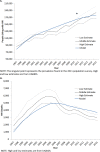Cost-effectiveness of a combination strategy to enhance the HIV care continuum in Swaziland: Link4Health
- PMID: 30222768
- PMCID: PMC6141095
- DOI: 10.1371/journal.pone.0204245
Cost-effectiveness of a combination strategy to enhance the HIV care continuum in Swaziland: Link4Health
Abstract
Introduction: Link4Health, a cluster-RCT, demonstrated the effectiveness of a combination strategy targeting barriers at various HIV continuum steps on linkage to and retention in care; showing effectiveness in achieving linkage to HIV care within 1 month plus retention in care at 12 months after HIV testing for people living with HIV (RR 1.48, 95% CI 1.19-1.96, p = 0.002). In addition to standard of care, Link4Health included: 1) Point-of-care CD4+ count testing; 2) Accelerated ART initiation; 3) Mobile phone appointment reminders; 4) Care and prevention package including commodities and informational materials; and 5) Non-cash financial incentive. Our objective was to evaluate the cost-effectiveness of a scale-up of the Link4Health strategy in Swaziland.
Methods and findings: We incorporated the effects and costs of the Link4Health strategy into a computer simulation of the HIV epidemic in Swaziland, comparing a scenario where the strategy was scaled up to a scenario with no implementation. The simulation combined a deterministic compartmental model of HIV transmission with a stochastic microsimulation of HIV progression calibrated to Swaziland epidemiological data. It incorporated downstream health costs potentially saved and infections potentially prevented by improved linkage and treatment adherence. We assessed the incremental cost-effectiveness ratio of Link4Health compared to standard care from a health sector perspective reported in US$2015, a time horizon of 20 years, and a discount rate of 3% in accordance with WHO guidelines.[1] Our results suggest that scale-up of the Link4Health strategy would reduce new HIV infections over 20 years by 11,059 infections, a 7% reduction from the projected 169,019 cases and prevent 5,313 deaths, an 11% reduction from the projected 49,582 deaths. Link4Health resulted in an incremental cost per infection prevented of $13,310 and an incremental cost per QALY gained of $3,560/QALY from the health sector perspective.
Conclusions: Using a threshold of <3 x per capita GDP, the Link4Health strategy is likely to be a cost-effective strategy for responding to the HIV epidemic in Swaziland.
Conflict of interest statement
The authors have declared that no competing interests exist.
Figures




References
-
- Centers for Disease Control. CDC in Swaziland: Factsheet 2013 [january 12, 2017]. Available from: https://www.cdc.gov/globalhealth/countries/swaziland/pdf/swaziland_2013.pdf.
-
- Kingdom of Swaziland Ministry of Health. Annual HIV Programs Report, 2015. In: Monitoring & Evaluation Unit: Strategic Information Department, editor. 2015.
Publication types
MeSH terms
Substances
Grants and funding
LinkOut - more resources
Full Text Sources
Other Literature Sources
Medical
Research Materials

